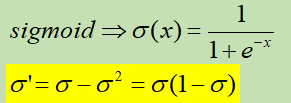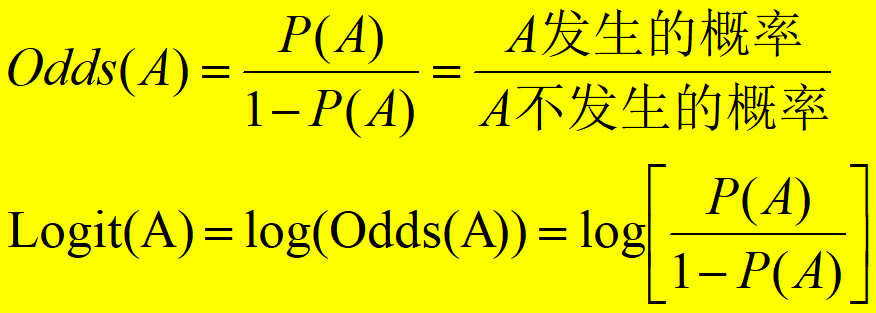基于TensorFlow和Python的机器学习(笔记4)
基于TensorFlow和Python的机器学习(笔记4)
loss
|
MSE =Mean Squared Error 均方差 |
|
|
Entropy熵 Cross Entropy交叉熵 |
熵越大,越不稳定,惊喜度越高 |
|
|
activation
|
sigmoid |
将每个值映射到0-1范围内 |
 |
|
softmax |
将每个值映射到0-1范围内,并且,所有值的和为1 小的变得更小,大的变得更大 |
 |
|
tanh |
tanh一般指双曲正切。 tanh是双曲函数中的一个,tanh为双曲正切。在数学中,双曲正切“tanh”是由双曲正弦和双曲余弦这两种基本双曲函数推导而来。 |
 |
|
Relu |
Rectified Linear Unit整形的线性单元 |
 |

矩阵乘法@ 或者matmul
a=tf.constant([[1,2],[3,4]])
# b=[[2],[3]]
# c=a@b
# print(c)
# c=tf.matmul(a,b)
# print(c)
# tf.Tensor(
# [[ 8]
# [18]], shape=(2, 1), dtype=int32)
# tf.Tensor(
# [[ 8]
# [18]], shape=(2, 1), dtype=int32)
#
# 进程已结束,退出代码0
只有元素个数为1的维度,才可以扩张(广播),
不是1个元素的无法在原维度上进行广播
a=tf.random.normal([2,1])
b=tf.broadcast_to(a,[2,4])
print(a)
print(b)
b=tf.broadcast_to(a,[3,2,4])
print(b)
tf.Tensor(
[[ 0.08891886]
[-2.0125113 ]], shape=(2, 1), dtype=float32)
tf.Tensor(
[[ 0.08891886 0.08891886 0.08891886 0.08891886]
[-2.0125113 -2.0125113 -2.0125113 -2.0125113 ]], shape=(2, 4), dtype=float32)
tf.Tensor(
[[[ 0.08891886 0.08891886 0.08891886 0.08891886]
[-2.0125113 -2.0125113 -2.0125113 -2.0125113 ]]
[[ 0.08891886 0.08891886 0.08891886 0.08891886]
[-2.0125113 -2.0125113 -2.0125113 -2.0125113 ]]
[[ 0.08891886 0.08891886 0.08891886 0.08891886]
[-2.0125113 -2.0125113 -2.0125113 -2.0125113 ]]], shape=(3, 2, 4), dtype=float32)
进程已结束,退出代码0
[5]只能扩充(广播)成[n,5]或者[m,n,5]而不能扩充成[5,n]或者 [5,m,n]
广播:只能在前面增加维度,而不能在后面增加维度
a=tf.random.normal([5])
print(a)
# b=tf.broadcast_to(a,[5,2])#Incompatible shapes: [5] vs. [5,2] [Op:BroadcastTo]
# print(b)
b=tf.broadcast_to(a,[2,5])
print(b)
# tf.Tensor([-0.12953417 1.4397062 -0.8788681 -0.1077985 -1.47903 ], shape=(5,), dtype=float32)
# tf.Tensor(
# [[-0.12953417 1.4397062 -0.8788681 -0.1077985 -1.47903 ]
# [-0.12953417 1.4397062 -0.8788681 -0.1077985 -1.47903 ]], shape=(2, 5), dtype=float32)
b=tf.broadcast_to(a,[2,2,5])
print(b)
# tf.Tensor(
# [[[ 0.7871988 1.055641 -0.23075646 -0.7903527 -1.0011079 ]
# [ 0.7871988 1.055641 -0.23075646 -0.7903527 -1.0011079 ]]
#
# [[ 0.7871988 1.055641 -0.23075646 -0.7903527 -1.0011079 ]
# [ 0.7871988 1.055641 -0.23075646 -0.7903527 -1.0011079 ]]], shape=(2, 2, 5), dtype=float32)
Odds(A)= 发生事件A次数 / 其他事件的次数(即不发生A的次数)
请注意Logit一词的分解,对它(it)Log(取对数),这里“it”就是Odds。

矩阵相加时的自动扩张(广播)
import tensorflow as tf
from tensorflow import keras
a=tf.zeros([3,2])
print('a=',a)
b=tf.ones([2,])
print('b=',b)
print('a+b=',a+b)
# a= tf.Tensor(
# [[0. 0.]
# [0. 0.]
# [0. 0.]], shape=(3, 2), dtype=float32)
# b= tf.Tensor([1. 1.], shape=(2,), dtype=float32)
# a+b= tf.Tensor(
# [[1. 1.]
# [1. 1.]
# [1. 1.]], shape=(3, 2), dtype=float32)
#
创建一个简单的全连接网络
import tensorflow as tf
from tensorflow import keras
print(tf.__version__) # 2.10.0
x = tf.random.normal([2, 3])
model = keras.Sequential([
keras.layers.Dense(2, activation='relu'),
keras.layers.Dense(2, activation='relu'),
keras.layers.Dense(2)
])
model.build(input_shape=[None,3])
# Model: "sequential"
# _________________________________________________________________
# Layer(type)
# Output
# Shape
# Param #
# == == == == == == == == == == == == == == == == == == == == == == == == == == == == == == == == =
# dense(Dense)(None, 2)
# 8
#
# dense_1(Dense)(None, 2)
# 6
#
# dense_2(Dense)(None, 2)
# 6
#
# == == == == == == == == == == == == == == == == == == == == == == == == == == == == == == == == =
# Total
# params: 20
# Trainable
# params: 20
# Non - trainable
# params: 0
两个矩阵可以相乘的条件是啥?
- 矩阵只有当左边矩阵的列数等于右边矩阵的行数时,它们才可以相乘;
- 乘积矩阵的行数等于左边矩阵的行数,乘积矩阵的列数等于右边矩阵的列数;
- 乘积矩阵的元素是左行乘右列再求和
|
RNN |
RNN一般指循环神经网络。 循环神经网络(Recurrent Neural Network, RNN)是一类以序列(sequence)数据为输入,在序列的演进方向进行递归(recursion)且所有节点(循环单元)按链式连接的递归神经网络(recursive neural network)。
|
|
GRNN |
门控循环神经网络(gated recurrent neural network)是为了更好地捕捉时序数据中间隔较大的依赖关系,
|
|
GRU |
门控循环单元(gated recurrent unit, GRU)是一种常用的门控循环神经网络 |
|
BiGRU |
BiGRU 是由单向的、方向相反的、输出由这两个 GRU 的状态共同决定的 GRU 组成的神经网络模型。 |
|
BiGRU-Attention |
BiGRU-Attention 模型共分为三部分:文本向量化输入层、 隐含层和输出层。其中,隐含层由 BiGRU 层、attention 层和 Dense 层(全连接层)三层构成。 |




【推荐】国内首个AI IDE,深度理解中文开发场景,立即下载体验Trae
【推荐】编程新体验,更懂你的AI,立即体验豆包MarsCode编程助手
【推荐】抖音旗下AI助手豆包,你的智能百科全书,全免费不限次数
【推荐】轻量又高性能的 SSH 工具 IShell:AI 加持,快人一步
· 震惊!C++程序真的从main开始吗?99%的程序员都答错了
· 【硬核科普】Trae如何「偷看」你的代码?零基础破解AI编程运行原理
· 单元测试从入门到精通
· 上周热点回顾(3.3-3.9)
· winform 绘制太阳,地球,月球 运作规律